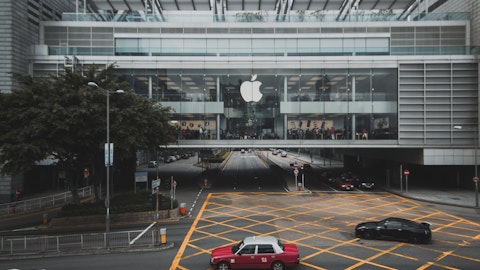John Pfeifer: International positions at Access have been relatively healthy, especially when you adjust for constant currency, currencies hurt us a little bit with the strong dollar. But if you adjust for constant currency, the European market is for us or our business in Europe, I should say, is up nicely. We’re up really strong in Latin America. I think the one outlier there is, of course, China. China is a huge market for the Access Equipment business, and we all know what’s going on in China, starting with the COVID lockdowns and how that’s really hindered the economy in China. So Asia-Pacific in total has been down year-over-year. Now some nice pockets of growth in there, but China kind of being down, pulls the whole region down.
We still do expect China to be over longer periods of time, a nice growth market. So this is likely a shorter-term phenomenon where we’ve seen China come down so sharply. But I would say, outside of China, it’s been maybe even better than expected around the world in terms of conditions and our ability to generate revenue.
Mike Shlisky: Great. Thanks. And then just turning to Vocational. You had mentioned wanted to grow this from $2 billion to $3 billion over the next couple of years. I’m just trying to get a sense as to why combine these two. Do you have plans to enter other locations over the next couple of years or is it going to be strictly fire, waste and whatever that of concrete going forward? Just some feel for what the mix might look like in a couple of years?
John Pfeifer: Yeah. So we’re really positive on the creation of a Vocational segment. This is going to do a lot for us. When you really look at what we’re doing in these — in the businesses that are in the Vocational market, they are purpose built vehicles designed to provide productivity and safety for a specific end market. And that’s what we do in that segment, whether it’s a fire truck or it’s a refuse or recycling collection vehicle and the other things that we do. This simplifies our business. Of course, it’s going to deliver some overhead or back office and production synergies. But the real positive that’s going to come is we’re going to leverage our scale to drive technology development at an even more accelerated pace.
You’ve seen us do a lot electric fire trucks, autonomous features coming online. We think we can do that faster to organically grow the business. We expect to organically get to $3 billion on the planning horizon that we’ve got. But then when you look at the inorganic moves that we believe we can make, we think that we potentially can even exceed that $3 billion. So this is a really exciting area for our company. And we did this because we believe we can drive margin growth with the revenue growth that we see on the horizon.
Mike Shlisky: Okay. Thanks. I’ll pass it along.
Operator: Our next question comes from the line of Chad Dillard with Bernstein. Please proceed with your question. Chad Dillard, your line is live.
Chad Dillard: Hi. Good morning, guys. So I was hoping you guys could talk a little bit more about your expectations for price cost cadence as well as just manufacturing absorption as you think about first half versus second half of this year?
Mike Pack: Sure. From a price cost perspective, I think the back half of 2022 is a good starting point because as we expected, we were pretty much price cost neutral in the back half of the year as a company and so that carries into next year. We’ve implemented additional price increases. So if you break that down a bit more by business, we’re at — particularly with the increase that we implemented at access were in that neutral to positive territory there as well as our historic commercial business. We have a little bit longer leg with our municipal customers and in Fire & Emergency just because of bonded orders. So we don’t necessarily get better and we have more price coming online. So we don’t necessarily get better with inflation in 2023.
So we looked at 2024, which we essentially have a pretty robust backlog for 2024 already, there is significant price increases like double-digit versus where we’re sitting today. So we expect as we get into 2024, those margins will return back to normal. But really, our expectation is as a company price cost neutral to positive for the full year. And that’s really measuring back to the start of inflation at 2021. Of course, from first half, we’ll certainly see quarter-over-quarter in the first half of the year, the benefits that we saw in the back half of 2022.





